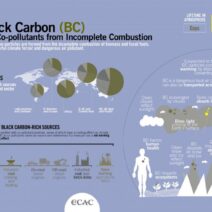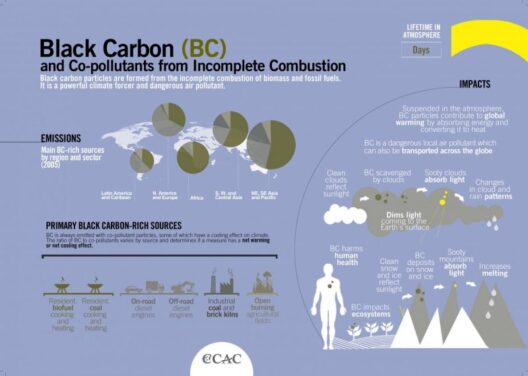The predilection for plastics in contemporary society has burgeoned into a complex conundrum. While plastics offer undeniable convenience and functionality, they also embody a paradox that belies their utility. The interaction between plastics and global warming must be scrutinized through a multidimensional lens that encompasses their lifecycle, from production through to disposal, illuminating their multifarious environmental costs.
At the very outset, it is crucial to understand that plastics are fundamentally derived from fossil fuels. The natural gas or crude oil undergoes a rigorous petrochemical process that yields resin, which eventually transforms into various plastic products. This initial phase—a gaping maw of hydrocarbons—sets the stage for what follows. The extraction, refinement, and polymerization of these hydrocarbons are monumental energy sinks. Consequently, the production of plastics emits a substantial volume of greenhouse gases (GHGs), fortifying the very atmospheric makeup of our planet and exacerbating the climate crisis.
The CO2 emissions associated with plastic production are staggering. Estimates reveal that for every ton of plastic produced, an average of 3.7 tons of CO2 is released. This ratio is equivalent to setting off a diesel engine for hours on end. These emissions cascade through the atmosphere, allowing sunlight to penetrate yet inhibiting the escape of reflected heat, thus entrapping warmth in a phenomenon famously termed the greenhouse effect.
However, the narrative regarding plastics and climate change does not end with their production. The utilization of plastics often extends into various sectors—including packaging, construction, and transportation—each sector contributing its own share to the carbon footprint. The sheer volume of single-use plastics is a glaring manifestation of this problem. Packaged goods, ubiquitous in consumer retail, are frequently encased in non-biodegradable plastics. These choices, while momentarily convenient, create monumental waste streams that subsequently displace environmental equilibria.
The consequences of plastic waste are manifold. Over time, plastics break down into microplastics through environmental exposure, invading terrestrial and marine ecosystems alike. This plastic pollution acts as a diabolical sorcerer; it not only disrupts food chains but alters the gravitational pull of carbon cycles. For instance, oceanic systems, which act as carbon sinks, face profound disarray due to the interference from microplastics disrupting the growth and functionality of phytoplankton—organisms essential for sequestering atmospheric CO2. The decline of these vital organisms can precipitate an acceleration of climate change, forming a vicious cycle of degradation.
The incineration of plastic waste presents another layer of complexity. While some might argue for the benefits of waste-to-energy conversion, this practice, in fact, releases dioxins, furans, and other toxic substances into the atmosphere alongside CO2. The baleful impact of such emissions poses a risk not merely for global warming, but for public health as well. The atmosphere increasingly becomes a toxic soup, further endangering vulnerable populations.
In the ongoing discourse surrounding carbon neutrality, plastics often find themselves ensconced in a dilemma: the choices we make regarding their use and disposal can have either a mitigative or exacerbative effect on climate change. While alternatives such as biodegradable materials are championed, they too come with their own set of environmental trade-offs. For example, the production of bioplastics—derived from corn or sugarcane—can necessitate a prodigious amount of agricultural land, which might otherwise be utilized for food production. This trade-off evokes the question: are we merely exchanging one form of environmental degradation for another?
When contemplating solutions, the concept of circular economy emerges as a beacon of hope. A circular model emphasizes the need to repurpose and recycle plastics, thereby diminishing the demand for virgin materials and curtailing emissions associated with production. This includes fostering innovations in recycling technologies to produce high-quality recycled plastics. Unlike conventional single-use paradigms, a circular economy employs a meticulous choreography that engages every stakeholder, from manufacturers to consumers, in sustainability practices that transcend typical waste management.
Furthermore, consumer behavior plays an instrumental role in this transformative process. Encouraging mindful consumption can facilitate demand for sustainable alternatives. The nexus of education and advocacy is paramount; the more individuals understand the environmental ramifications of their choices, the more likely they are to seek out eco-friendly options. Convening community workshops on plastic reduction strategies or harnessing the power of social media for awareness campaigns can ripple through society, catalyzing change.
Regulatory frameworks must also pivot toward mitigating the adverse effects of plastic proliferation. Governments around the world could enact stricter regulations that incentivize the reduction of plastics in favor of sustainable wooden, glass, or metal alternatives. By placing a price tag on plastic pollution—through taxes or fees—policymakers would not only encourage the reduction of plastic use but also raise funds for environmental restoration initiatives.
The complexity of plastics and their role in accelerating global warming underscores an urgent need for an integrative approach—one that fuses production, usage, and disposal into a coherent strategy aimed at sustainability. The allure of convenience embodied by plastics must be grappled with the understanding of their enduring environmental cost. As citizens of Earth, we must weigh this juxtaposition with conscientious deliberation and fortify our resolve to embrace transformative practices. Only then can we aspire to mitigate the far-reaching effects of climate change and create a legacy of stewardship for future generations.






